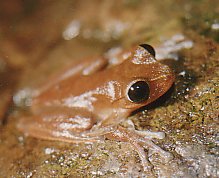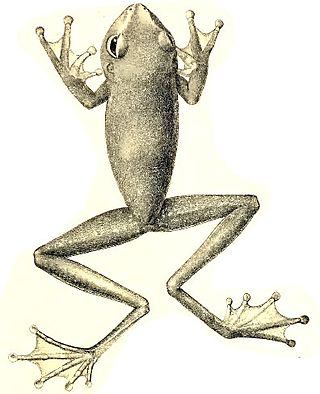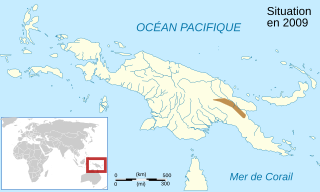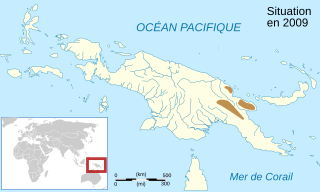
Nyctimystes is a genus of tree frogs in the subfamily Pelodryadinae of the family Hylidae. They are principally Papuan species, but also inhabit islands in the Moluccas. All species in this genus have one distinct feature that separates them from other species in the family, the lower eyelid is marked with pattern of lines, veins, or dots. This feature presumably acts as camouflage when the frogs are at rest during the day.
Ranoidea brongersmai is a species of frog in the subfamily Pelodryadinae. It is endemic to New Guinea and known from its type locality in the Snow Mountains, and according to the IUCN Red List of Threatened Species, from another location in the Wapoga River headwaters some 100 km further west. Both sites are in Western New Guinea (Indonesia). Its range is probably broader than current knowledge suggests. The specific name brongersmai honours Leo Brongersma, a Dutch author and zoologist. Accordingly, the common name Brongersma's treefrog has been proposed for it.
Nyctimystes avocalis is a species of frog in the subfamily Pelodryadinae. It is endemic to Papua New Guinea and is only known from its type locality on the east slope of Goodenough Island, one of the D'Entrecasteaux Islands. It has been given the common name loud big-eyed treefrog.
Nyctimystes fluviatilis, also known as the Indonesian big-eyed tree frog, is a species of frog in the subfamily Pelodryadinae of the family Hylidae. It is endemic to New Guinea and is known from Idenburg River and Wapoga River in Papua province, Indonesia, and from the Torricelli Mountains in the East Sepik Province and Kavorabip in the Western Province, both in the western Papua New Guinea.
Nyctimystes gularis, the Mondo big-eyed tree frog, is a species of frog in the subfamily Pelodryadinae, endemic to Papua New Guinea. Its natural habitats are subtropical or tropical moist montane forests and rivers.
Nyctimystes kubori is a species of frog in the subfamily Pelodryadinae of the family Hylidae. It is endemic to Papua New Guinea and is widespread in the New Guinea Highlands between 141°E and 147°E and in the mountains of the Huon Peninsula. The specific name kubori refers to its type locality in the Kubor Mountains. Common name sandy big-eyed treefrog has been coined for this species.

Nyctimystes montanus is a species of frog in the subfamily Pelodryadinae. It is endemic to the Arfak Mountains, located in the Bird's Head Peninsula of northwestern New Guinea. This species is only known from its type locality. There are no records of this species after it was described in 1878, perhaps because of lack of surveys.
Nyctimystes narinosus, the common big-eyed treefrog, is a species of frog in the subfamily Pelodryadinae of the family Hylidae. It is endemic to New Guinea and occurs in the Wahgi-Sepik Dividing Range and the Schrader Mountains, on both sides of the border between Papua (Indonesia) and Papua New Guinea. There is, however, some uncertainty about the western limit of this species. Despite its vernacular name, Nyctimystes narinosus is not a common species.
Nyctimystes perimetri, also known as the archipelago big-eyed treefrog, is a species of frog in the subfamily Pelodryadinae of the family Hylidae. It is endemic to Papua New Guinea and currently only known from the Louisiade Archipelago, although it might also occur in the Owen Stanley Range of the mainland Papua New Guinea. It has also been suggested that the Rossel Island population might represent a distinct species.
Nyctimystes persimilis, also known as the Milne big-eyed treefrog, is a species of frog in the subfamily Pelodryadinae of the family Hylidae. It is endemic to Papua New Guinea and known from Mount Dayman and Mount Simpson in the Owen Stanley Range.
Nyctimystes trachydermis, also known as the Morobe big-eyed treefrog, is a species of frog in the subfamily Pelodryadinae of the family Hylidae. It is endemic to Papua New Guinea and occurs in the mountains of southern eastern New Guinea. Its type locality is Gapaia Creek, at 1,280 m (4,200 ft) asl between Garaina and Saureli, in the Morobe Province. The specific name trachydermis means "rough skinned", derived from the Greek words trachys and derma.
Nyctimystes tyleri is a species of frog in the subfamily Pelodryadinae of the family Hylidae. It is endemic to Papua New Guinea and only known from its type locality, Gapaia Creek, between Garaina and Saureli, in the Morobe Province. The specific name honours Michael J. Tyler, an Australian herpetologist, "in recognition of his notable contributions to the systematics of Australo-papuan frogs." Common name Tyler's big-eyed treefrog has been coined for this species.
Aphantophryne sabini is a species of frog in the family Microhylidae. It is endemic to Papua New Guinea and is only known from the region of its type locality, Myola Guest House in the Owen Stanley Range, Northern Province. The specific name sabini honors Andrew E. Sabin, an American businessman, philanthropist, and environmentalist who joined the expedition during which the holotype of this species was collected. However, its vernacular name Guest House Guinea frog refers to the type locality instead.
Austrochaperina basipalmata is a species of frog in the family Microhylidae. It is endemic to the mountain ranges of northern New Guinea and is found between Tawarin River in Papua, Western New Guinea (Indonesia) and Torricelli Mountains in Papua New Guinea.

Cophixalus parkeri is a species of frog in the family Microhylidae. It is endemic to Papua New Guinea where it occurs in the central mountainous region between Chimbu and Morobe Provinces. The specific name parkeri presumably honours Hampton Wildman Parker, an English zoologist and herpetologist to whose perusal Arthur Loveridge sent the holotype. Common name Papua rainforest frog has been coined for it.
Cophixalus riparius is a species of frog in the family Microhylidae. It is endemic to Papua New Guinea and occurs in the New Guinea Highlands in Madang, Southern Highlands, and Western Highlands provinces southeastward to the Morobe Province. The specific name riparius refers to the creek-side habitat from which many specimens in the type series were collected. Common name Wilhelm rainforest frog has been coined for this species.

Cophixalus shellyi is a species of frog in the family Microhylidae. It is endemic to Papua New Guinea and occurs in the New Guinea Highlands as well as in the Adelbert Range and on the Huon Peninsula. The specific name shellyi honors Father Otto Schellenberger ("Shelly"), an American missionary and former professor in mathematics who collected the type series.
Cornufer guppyi is a species of frog in the family Ceratobatrachidae. The species is named after British surgeon Henry B. Guppy who collected the holotype from the Shortland Islands. It is found in New Britain Island and in the Solomon Islands archipelago, where it is widespread, though it is missing from Makira island.
Cornufer batantae is a species of frog in the family Ceratobatrachidae. It is endemic to West Papua, Indonesia, and is known from two islands near the New Guinean mainland, Batanta and Waigeo. There are also unconfirmed records from Yapen and Gag Islands. Common name Batanta wrinkled ground frog has been coined for the species.
Cornufer punctatus, commonly known as the dotted wrinkled ground frog, is a species of frog in the family Ceratobatrachidae. It is endemic to Western New Guinea (Indonesia) and occurs in the Arfak and Wondiwoi Mountains on the New Guinea mainland well as on some adjacent islands.





